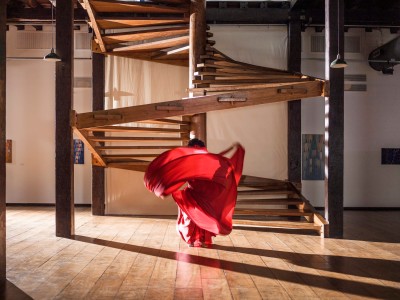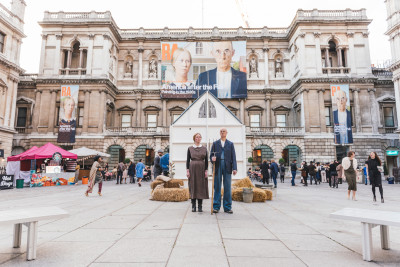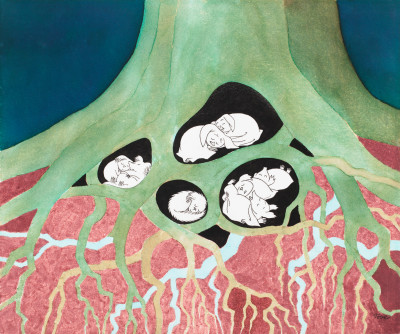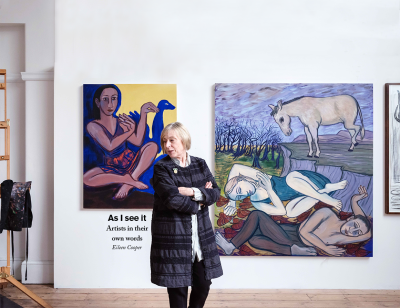The state of British art in 2015
The state of British art in 2015
By Anna Coatman
Published 13 November 2015
With British Art Show 8 and the Turner Prize 2015 both showcasing the cutting edge of British art, Anna Coatman outlines five trends of a generation – from a digital backlash to the idea of Britishness itself.
-
The Turner Prize is one of Europe’s most prestigious – and notorious – annual contemporary art awards. The British Art Show happens every five years, showcasing a selection of the best, most representative contemporary art from the UK. What do this year’s shows tell us about the state of British contemporary art?
1. “British artists” come from all over the world
Almost half of the 42 artists in the British Art Show 8 were born outside the UK, as were two out of the four Turner Prize 2015 nominees. Are more artists from around the world being drawn to the British art scene? Whatever the truth, the contemporary art world is undoubtedly growing ever more global and labels like “British artist” are becoming broader.London is as global as a city can get, and much of the UK art scene – not to mention the international art market – is clustered in the capital. But both Turner 2015 and BAS8 are taking place in other regions: the venue for the former is the Tramway in Glasgow, while the latter is hosted by Leeds Art Gallery before it travels to Edinburgh, Norwich and Southampton in 2016. The high cost of London living is a hot topic in the art world, with the art market growing and the number of affordable homes (let alone studio spaces) rapidly shrinking. Is it possible that things have reached a tipping point, and that swathes of artists will follow the suit of Turner 2015 and BAS8 and go further afield over the next five years?
2. But geography still has a place in contemporary art
There’s little overt exploration of “Britishness” – whatever that might mean – in either BAS8 or the Turner Prize. However, at BAS8 a sense of place is tangibly present in Jessica Warboys’ Sea Paintings: huge, battered canvases that have been dragged from the sea, stretched out on the beach, and scattered with mineral pigments. Warboys has created a site-specific Sea Painting for each BAS8 venue; Spurn Point 2015, which hangs dramatically above the grand staircase in Leeds Art Gallery, was made on the East Yorkshire coast.In a more political sense, place is also intrinsic to Stuart Whipps’ The Kipper and the Corpse (2015), an artwork which explores the casualties of market-driven globalisation, centring on the Longbridge Motor plant in Birmingham. The factory was shut down and relocated to China in 2005, resulting in the loss of 6,500 local jobs. The shell of a GT Mini that was made there in 1979 now sits in Leeds Art Gallery; Whipps will be enlisting ex-Longbridge employees to restore it before exhibiting the finished product at BAS8’s final Southampton venue.
-

Martino Gamper, Post Forma, 2015

Sea Painting, Jessica Warboys, 2015.

Rachel Maclean, Feed Me, Scene 8, 2015.

Stuart Whipps, The Kipper and the Corpse, 2015.
-
3. Today’s artists are getting “real”
Perhaps we need to be reminded of our place in the real world, as we’re spending more and more of our time in the digital one. The curators of BAS8 think so, arguing that many artists are now questioning our over-reliance on the internet and other digital technologies. The theme of BAS8 is “The capacity of things”, and each work in the show has either been commissioned or selected because it somehow explores materiality in a new way. For instance, The Ideal (2015) by Yuri Pattison is a part-sculpture, part-film installation, taking a Chinese Bitcoin mine (a large, specialised data centre) as its subject. Featuring footage of the mine, the nearby hydroelectric dam that powers it, and the surrounding natural landscape, as well as objects that reference the mine’s energy-intensive processes, this work reminds us that the seemingly limitless internet ultimately runs on unsustainable fossil fuels.
-
Many artists are now questioning our over-reliance on the internet and other digital technologies
-
While some artists focus on the ways in which new technologies damage the environment, others focus on how they damage society. Rachel Maclean’s film Feed Me (2015) depicts a candy-coloured nightmare world where a sleazy toy corporation peddles synthetic “happiness” to the infantilised masses. One of the interesting things about Maclean is that while she satirises our dependency on social media, she also gleefully embraces digital technology – applying layer upon layer of computer graphics to her films. Elsewhere in BAS8, there’s a palpable sense of nostalgia for a pre-internet age and the skills and technologies we’ve forgotten. Several artists take obsolete analogue technologies as raw material for their art. Eileen Simpson and Ben White have created an audiovisual work using of out-of-copyright chart hit records, and Charlotte Prodger flashes the names of racehorses across repurposed video monitors in Northern Dancer (2014). Elsewhere, there’s a focus on tactile objects: Caroline Achaintre’s colourful hand-tufted textiles and rubbery masks, Aaron Angell’s crudely modelled ceramics, and Simon Fujiwara’s shaved fur coats are just a few examples.
At Turner 2015, however, Nicole Wermers is the only nominee presenting object-based, material-centred work in the show. She has stitched the linings of vintage fur coats onto chairs to create Untitled Chairs (2014-15), a reflection on the ways individuals try to stake small claims to public space. She has also created large, permanent, ceramic versions of the ephemeral paper signs with tearable slips that people stick to trees, lampposts and shop windows. Janice Kerbal, on the other hand has created a performance piece: at intervals, a professional choir performs DOUG (2014), a libretto that the artist wrote, after giving herself a year to learn this new skill completely from scratch. Bonnie Camplin, meanwhile, has created a kind of library space within the gallery – complete with municipal building-style grey carpet and photocopier. The Military Industrial Complex (2014) is a reading room, soundproofed from Kerbal’s adjacent choir, where visitors can retreat from the rest of the exhibition and watch video interviews with conspiracy theorists, or read about alternative belief systems such as aliens, witchcraft, conspiracies and astrology.
-
-

4. Art doesn’t have to be made by artists
It wouldn’t be the Turner Prize if people weren’t asking: “but is it art?” True to form, the Turner Prize has courted controversy this year by shortlisting a community project organised by Assemble, described in the Turner Prize programme as a “multi-disciplinary collective working across architecture, design and art.” In the latest of a series of UK-wide projects, the London-based collective has worked with a group of local residents in Toxteth, Liverpool, to renovate a cluster of terraced houses threatened with demolition. Assemble has also set up a workshop in what was a boarded-up shop, where local people make household items and fittings based on those used in the refurbished houses.You can pick up a catalogue of these handmade items when you visit the Turner Prize; a corner of the Tramway Gallery has been transformed into a kind of marketing showroom for the Granby Four Streets project, displaying the products that are available to buy online. The nomination of this artwork raises a number of questions: Where does the community project end and the high art concept begin? What distinguishes the “intervention” of Assemble from the work the Granby Four Streets Community Land Trust was already doing? Should the value of art be measured by its social usefulness? Similar questions are also raised at BAS8, where Martino Gamper has organised a series of workshops manned by skilled craftspeople from the local area. Visitors can watch and learn from cobblers, bookbinders and chair makers at work in the middle of Leeds Art Gallery. They can even get their shoes repaired. But are the craftspeople the artists who are making the art, or is it the artist who put them there?
-
-
5. Art is changing – and art galleries are changing too
The art selected for the British Art Show 8 and The Turner Prize 2015 is incredibly diverse – including all kinds of different art forms, from painting, to performance, from ant farms to workshops. The two shows illustrate the broad range of work being produced by contemporary British artists – and the kinds of challenges this work presents to art galleries. Sound overlaps from one art work into the next; floor space is needed as much as wall space. A great deal of contemporary art is now participatory, performance-based and audio-visual. Galleries are no longer just places to look at art, but also places to listen to it and even make it too.
-

Nicole Wermers

Janice Kerbel

Bonnie Camplin
-
Anna Coatman (@AnnaCoatman) is Assistant Editor of RA Magazine.
British Art Show 8 is at Leeds Art Gallery until 10 January 2016 then touring.Turner Prize 2015 is at Tramway, Glasgow until 17 January 2016.











